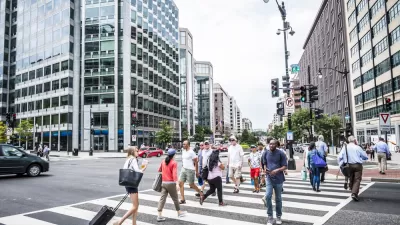The growing popularity of active transportation requires planners and advocates to better survey how, where, and when people are biking and walking. A new study by the Transportation Research Board shares the cutting edge of survey techniques.
The Transportation Research Board has released a new study called “Monitoring Bicyclist and Pedestrian Travel and Behavior.” The study gathers and disseminates the growing body of knowledge of technology and techniques for monitoring the active transportation modes of walking and biking.
Acknowledging that the “methods to monitor the traffic of [biking and walking] have been slow to advance until the last decade or so” the report sets out to “chronicle the most recent advancements in techniques and technology of active transportation monitoring…”
As evidence of the growing need to monitor active forms of transportation—by planners and engineers as well as citizen advocates—the report claims that the results of a search in Google Scholar for the terms “bicycle pedestrian traffic count,” produced more than 1,600 results in 2011, up from only about 50 related publications in 1990.
Such monitoring activities have already gained institutional legitimacy as well. “The past year (2013) has brought a major revision of FHWA’s Traffic Monitoring Guide (TMG)…[which] includes for the first time a chapter on monitoring bicycling and walking (Chapter 4: Traffic Monitoring for Non-Motorized Traffic).”
The report includes guidance on manual techniques, portable counters, and permanent counters, as well archiving and sharing data.
FULL STORY: Monitoring Bicyclist and Pedestrian Travel and Behavior

Alabama: Trump Terminates Settlements for Black Communities Harmed By Raw Sewage
Trump deemed the landmark civil rights agreement “illegal DEI and environmental justice policy.”

Planetizen Federal Action Tracker
A weekly monitor of how Trump’s orders and actions are impacting planners and planning in America.

The 120 Year Old Tiny Home Villages That Sheltered San Francisco’s Earthquake Refugees
More than a century ago, San Francisco mobilized to house thousands of residents displaced by the 1906 earthquake. Could their strategy offer a model for the present?

In Both Crashes and Crime, Public Transportation is Far Safer than Driving
Contrary to popular assumptions, public transportation has far lower crash and crime rates than automobile travel. For safer communities, improve and encourage transit travel.

Report: Zoning Reforms Should Complement Nashville’s Ambitious Transit Plan
Without reform, restrictive zoning codes will limit the impact of the city’s planned transit expansion and could exclude some of the residents who depend on transit the most.

Judge Orders Release of Frozen IRA, IIJA Funding
The decision is a victory for environmental groups who charged that freezing funds for critical infrastructure and disaster response programs caused “real and irreparable harm” to communities.
Urban Design for Planners 1: Software Tools
This six-course series explores essential urban design concepts using open source software and equips planners with the tools they need to participate fully in the urban design process.
Planning for Universal Design
Learn the tools for implementing Universal Design in planning regulations.
Clanton & Associates, Inc.
Jessamine County Fiscal Court
Institute for Housing and Urban Development Studies (IHS)
City of Grandview
Harvard GSD Executive Education
Toledo-Lucas County Plan Commissions
Salt Lake City
NYU Wagner Graduate School of Public Service




























